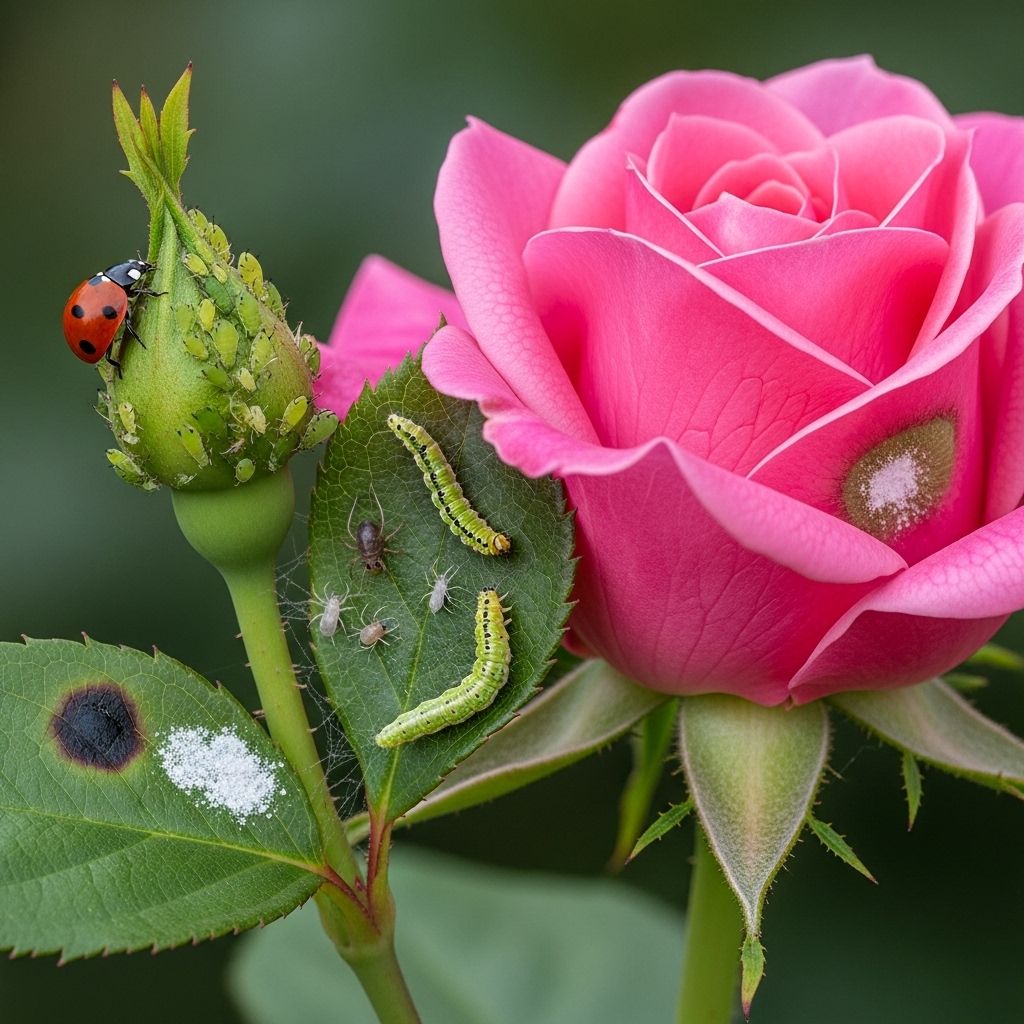11 Common Rose Pests: Identification, Treatment & Prevention
From microscopic mites to chafers, discover practical tactics to protect blooms year-round.

Image: HearthJunction Design Team
11 Most Common Rose Pests: Identification, Treatment & Prevention
Roses are beloved garden classics, renowned for their beauty and fragrance. However, these hardy plants are also magnets for a wide range of destructive pests. If you’ve ever noticed chewed leaves, deformed buds, webs, or colonies of insects on your rose bushes, you’re not alone. Understanding the signs of infestation, learning to identify the culprit, and knowing how to treat and prevent them is essential for any rose gardener. In this comprehensive guide, we’ll take you through the 11 most common pests that attack roses, how to spot them, and the best strategies for control and prevention.
Contents
- Spider Mites
- Aphids
- Japanese Beetles
- Rose Slugs (Sawflies)
- Thrips
- Rose Midges
- Caterpillars
- Leafcutting Bees
- Scale Insects
- Rose Chafers
- Earwigs
- Frequently Asked Questions (FAQs)
Spider Mites
Spider mites are nearly microscopic, eight-legged pests that are notorious for attacking roses during hot and dry conditions. Though small, their presence is marked by distinctive signs:
- Sticky white webbing under leaves
- Tiny yellow spots that merge into dull, brown foliage
- Often found on leaf undersides
These mites suck chlorophyll, causing leaves to lose color and vitality. Keeping plants hydrated and stress-free is the first defense. Treat infestations by rinsing with water and applying insecticidal soap or horticultural oil if necessary.
Aphids
Aphids are small, soft-bodied insects—typically green, but sometimes pink or black—that cluster on tender new growth, buds, and stems. They pierce plant tissue and suck out sap, resulting in:
- Wrinkled, curling leaves and deformed buds
- Sticky residue (honeydew) on leaves and stems
- Attraction of ants and development of black sooty mold
Aphids multiply rapidly, often going from a minor nuisance to a major infestation within days. Control them by spraying with a strong stream of water, removing infested stems, or applying insecticidal soap. Introducing beneficial insects, such as ladybugs, can also help keep aphid populations in check.
Japanese Beetles
Japanese beetles are distinctive, shiny metallic-green insects with copper-brown wings. They are voracious feeders and can rapidly skeletonize rose leaves and attack flowers. Signs of Japanese beetle damage include:
- Large, irregular holes in leaves, often leaving only veins
- Flowers chewed and ruined
Hand-picking and dropping beetles into soapy water is effective for small infestations. For larger populations, consider using traps placed away from roses, or targeted horticultural sprays. Maintaining healthy lawns and gardens can also reduce grub populations, the juvenile form of this pest.
Rose Slugs (Sawflies)
Rose slugs are the larvae of sawflies and resemble tiny, green caterpillars. They blend in with foliage and can be tricky to spot, but if you see holes in leaves that seem to appear overnight, check leaf undersides for:
- Small, slimy, green larvae
- Skeletonized leaves (where only veins remain)
Remove rose slugs by hand or spray them off with water. For persistent infestations, use horticultural oils or insecticidal soap. Regular inspection, especially in spring, is crucial to catch new larvae early and protect new growth.
Thrips
Thrips are minute, slender insects that feed by rasping tissue and sucking up plant fluids. They are notorious for damaging roses in early to mid-summer. Look out for:
- Distorted, twisted new leaves
- Yellow flecking or streaking on foliage
- Deformed buds that fail to open, or premature bud drop
- Streaked and withering blossoms
Thrips can be managed by removing and destroying affected buds and flowers, using blue or yellow sticky traps, and applying neem oil or insecticidal soap. Encourage natural predators like lacewings and minute pirate bugs for biological control.
Rose Midges
Rose midges are tiny flies whose larvae can devastate rosebuds and leaves. The microscopic, whitish maggots feed on delicate tissues, causing:
- Blackened, shriveled leaves and blossoms
- Sudden bud abortion (buds stop developing and die back)
Infestations usually start after the first bloom cycle and may persist throughout the season if left unchecked. Remove and destroy infested buds and leaves immediately to limit spread. Applying a soil drench with a systemic insecticide can help break the life cycle, but always follow label instructions to minimize harm to beneficial insects.
Caterpillars
Various caterpillars find rose leaves and buds irresistible. Common types include leafrollers and inchworms. These larvae cause:
- Chewed holes in leaves and flowers
- Tied or rolled leaves (from leafrollers)
Handpick caterpillars when possible. For heavier infestations, apply Bacillus thuringiensis (Bt), a biological insecticide safe for humans and wildlife but highly effective against caterpillars. Encourage birds in your garden as natural predators.
Leafcutting Bees
Leafcutting bees are solitary pollinators that cut neat, circular sections from rose leaves to line their nests. While the visual effect may seem alarming, their damage is mostly cosmetic, and they do not threaten the rose’s health or vigor. In fact, leafcutting bees are valuable for pollination. No treatment is necessary; simply tolerate their presence as part of a healthy garden ecosystem.
Scale Insects
Scale insects are tiny, shell-like pests that attach to canes and stems, appearing as small bumps. They weaken plants by sucking sap, leading to:
- Yellowing or wilting leaves
- Poor growth and dieback of stems
Prune and destroy heavily infested stems. Apply horticultural oil during the dormant season to smother overwintering stages. For light infestations, scrape off with a soft brush.
Rose Chafers
Rose chafers are tan-colored beetles with long, spindly legs. Active in late spring, they feed on roses, especially flowers and foliage. Symptoms of their activity include:
- Chewed petals and leaves
- Brown-edged holes, particularly on pale or white roses
Handpicking is usually sufficient for control. Remove beetles early in the morning and drop them into soapy water. Covering plants with row covers during peak beetle activity can provide temporary protection.
Earwigs
Earwigs are nocturnal insects with pincers (forceps) at their tail end. Though they consume decaying plant material and some pests, they may also nibble on rose buds and leaves, causing:
- Irregular holes in petals and leaves
- Chewed buds and flowers
Encourage natural predators such as birds and toads. Trap earwigs by setting rolled-up damp newspapers or shallow dishes of oil near roses at night and disposing of captured earwigs in the morning.
Comparison Table: Common Rose Pests at a Glance
| Pest | Signs of Damage | Primary Control Methods |
|---|---|---|
| Spider Mites | Webbing, yellow/brown leaves | Water spray, insecticidal soap |
| Aphids | Curling leaves, honeydew, mold | Water spray, remove by hand, beneficial insects |
| Japanese Beetles | Skeletonized leaves, devoured flowers | Hand-pick, traps, targeted spray |
| Rose Slugs | Holes in leaves, skeletonization | Hand removal, oils, soap |
| Thrips | Distorted buds, streaked flowers | Remove damaged buds, sticky traps, neem oil |
| Rose Midges | Blackened buds, leaf dieback | Remove infested parts, systemic insecticide |
| Caterpillars | Chewed leaves/flowers | Hand-pick, Bt, encourage birds |
| Leafcutting Bees | Round cuts on leaves | Tolerate (beneficial pollinators) |
| Scale Insects | Shell-like bumps, yellowing leaves | Prune, horticultural oil, scraping |
| Rose Chafers | Chewed petals, brown-edge holes | Hand-pick, row covers |
| Earwigs | Irregular holes in petals/leaves | Traps, encourage predators |
Integrated Pest Management: Prevention & Organic Control
While reactive treatments can save your roses during an outbreak, the best philosophy is preventive care and integrated pest management (IPM). Consider these strategies for long-term rose health:
- Keep roses healthy: Well-watered, well-fed plants resist pests better.
- Inspect frequently: Look under leaves for pests or symptoms each week, especially in spring and summer.
- Prune and clean: Remove dead, damaged, or infested leaves/buds promptly; keep the area beneath roses clean of debris.
- Encourage beneficial insects: Ladybugs, lacewings, birds, and other predators help keep pest populations in check.
- Use physical barriers: Row covers can help during peak beetle years.
- Apply targeted organic sprays: Insecticidal soaps, neem oil, and horticultural oils are effective for many pests if regular monitoring is practiced.
- Avoid unnecessary chemicals: Broad-spectrum insecticides can harm beneficial insects and worsen pest problems long-term.
When to Seek Professional Help
If pest infestations become overwhelming or if you’re unsure about correct identification, consult your local extension service or a professional horticulturist for assistance. Correct diagnosis ensures proper treatment and prevents unnecessary harm to your plants or garden environment.
Frequently Asked Questions (FAQs)
Q: What is the most common pest on rose bushes?
A: Aphids are among the most commonly encountered pests on roses, quickly building large populations that damage buds and new leaves.
Q: Are there organic ways to control rose pests?
A: Yes! Integrated pest management, including beneficial insects, hand-removal, strong water sprays, and organic products like neem oil and insecticidal soap, is highly effective for most home gardeners.
Q: How often should I check my roses for pests?
A: Inspect your roses at least once a week during the growing season. Regular monitoring catches problems early, making treatment easier and more effective.
Q: Will pests kill my rose bushes?
A: Most pests will not kill established roses outright, but heavy infestations can significantly weaken plants, reduce blooms, and make roses more susceptible to diseases and environmental stresses.
Q: Should I use chemical pesticides on my roses?
A: Use chemical pesticides as a last resort. They often harm beneficial insects and pollinators. Focus instead on organic methods and fostering a healthy garden ecosystem.
Conclusion
Dealing with rose pests is one of the inevitable challenges of creating a thriving rose garden, but it doesn’t have to be discouraging. Start with regular observation, prompt removal of affected foliage, and the encouragement of natural predators. With knowledge of the 11 most common rose pests and a comprehensive prevention strategy, your roses can remain healthy, vigorous, and a showpiece of your garden for years to come.
References
- https://www.epicgardening.com/rose-pests/
- https://www.epicgardening.com/black-spot-roses/
- http://www.missouribotanicalgarden.org/Portals/0/Gardening/Gardening%20Help/Visual%20Guides/Rose%20Problems.pdf
- https://www.gardentech.com/blog/garden-and-lawn-protection/protecting-roses-from-aphids-and-other-common-pests
- https://www.provenwinners.com/learn/plant-growing-guide/caring-roses-ultimate-guide
Rose Pest Control: ID, Treatment & Prevention Tips
Watch now to discover how to identify, treat, and prevent aphids, beetles, spider mites, and more common rose pests. Protect your blooms with easy, proven organic and chemical tips.
Read full bio of medha deb












